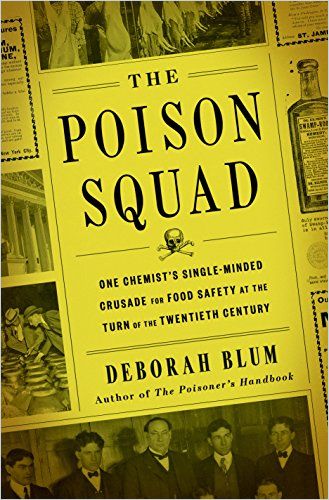Pulitzer Prize winning reporter Deborah Blum details the remarkable history of the United States’ pioneering advocate for consumer protection.

An American Hero
Deborah Blum – who won a Pulitzer Prize reporting for The Sacramento Bee – also wrote The Biologicial Differences Between Men and Women. Her books have won multiple awards for their rigorous reporting and immersion in the their eras. Blum turns her reporting skills onto the life of Harvey Washington Wiley, a heroic and little known American.
As 19th-century America industrialized, Blum reports, so did its food and beverage businesses. In 1862, President Abraham Lincoln created the US Department of Agriculture (USDA). In 1883, in what Blum describes as an unintended revolutionary act, the USDA hired Harvey Washington Wiley as chief chemist. His office began monitoring the nation’s food supply.
Bureau of Chemistry
Wiley called for clear, precise food labeling. His Bureau of Chemistry, Blum relates, launched investigations into suspect foods, starting with milk and other dairy products.
Cutter,” Wiley said, “I’m going to marry that girl.” “Perhaps it would be well for you to meet the young lady before proposing matrimony,” Cutter replied. Deborah Blum48
In 1893, President Grover Cleveland appointed a Blum opponents, Julius Sterling Morton, as secretary of the USDA. Morton, Blum tells, slashed Wiley’s budget and suppressed his findings. In 1897, President William McKinley appointed a new secretary, James Wilson, a former Congressman. Wilson restored Wiley’s budget.
Around this time, Blum reports that Wiley, 53, met and fell in love with USDA librarian Anna Kelton, then 21. When Wiley proposed, Kelton called off their relationship and transferred to the Library of Congress.
Blum explains that, in the late 1800s, butchers and milk distributors often used Freezine and Preservaline – preservatives containing formaldehyde – in their products. Children were dying from the formaldehyde in food. Blum reports that Wiley made an unprecedented call for food standards and urged accurate ingredient labeling and additive testing, but his opponents halted legislative action.
Poison Squad
By 1901, Blum explains that tmanufacturers patented 152 preservatives. Johns Hopkins University developed saccharin to replace sugar, and made artificial mint and lemon flavorings; this, Blum details, further displaced farmers from the food supply chain. Blum reports that chemical companies such Pfizer, Monsanto and Dow created additional preservatives and food additives. Wiley established controlled “table trials,” in which subjects would eat meals with varying doses of whatever chemical compound the Bureau of Chemistry was studying.
To Wiley’s chagrin, Blum notes that Washington Post reporter George Rothwell Brown publicized this process, dubbing’s group the Poison Squad.
The Jungle
Blum recounts that the National Food Manufacturers Association paid scientists to defend their products and details their arguments that preservatives contributed to human well-being. Advocate Alice Lakey became an important Wiley ally. Blum explains that Lakey organized rallies held by the National Consumers League and by women’s clubs, which invited Wiley to speak. One invitation came from Anna Kelton, who married Wiley in 1910.
In 1904, Upton Sinclair’s novel The Jungle cited how meat companies bribed USDA inspectors when sellers brought diseased animals to Chicago slaughterhouses and other horrific practices. Congress pushed for a pure food law. Theodore Roosevelt signed the Meat Inspection Act along with the Food and Drug Act on June 30, 1906. In Blum’s retelling, this was a triumph for Wiley.
James Wilson
Blum untangles the political web Wiley had to negotiate. Wilson created the Board of Food and Drug Inspection and appointed Wiley. Blum uncovers how Wilson and his ally Dunlap conspired to weaken Wiley’s recommended food-coloring safety guidelines.
For many involved in the pure-food case, the battles had become seemingly unending, largely because of the inadequacy of the 1906 food law itself.(Deborah Blum)
In July 1911, Blum shows how The New York Times depicted Wiley and his Bureau as crusaders for the public interest, and Wilson and others as corrupt industry puppets. Wiley’s supporters, Blum reveals, flooded the USDA, the White House and Congress with messages. Nothing came of the reports.
Good Housekeeping
Blum reports that manufacturers went directly to Wilson, who routinely revised Wiley’s orders. Wiley resigned to join Good Housekeeping magazine. Blum presents this as a positive move for Wiley, who doubled his salary and gained a public platform for columns on safe, healthy food and the need for regulation.
Walter G. Campbell head of the new Food and Drug Administration (FDA), Blum concludes, believed in “Dr. Wiley’s Law,” the 1906 Pure Food and Drug Act. Wiley died on June 30, 1930, the law’s 24th anniversary.
Following an uptick in chid deaths, the department had surveyed physicians and found that almost all the recent infant deaths were related to preservatives in milk.(Deborah Blum)
In 1937, a cough syrup sweetened with poison killed more than 100 people. Blum credits public outrage with the passage of the Food, Drug and Cosmetics Act of 1938.
Straightforward and Detailed
As befits a Pulitzer Prize winner, Deborah Blum untangles history, much of it outrageous in its greed and duplicity, without succumbing to outrage herself. Blum presents Wiley as an American hero. Blum dug deeply into the testing, politicking and stonewalling enemies that informed Wiley’s life. Wiley’s enemies and allies – many dominant figures in US history – showcasesBlum’s skill as she brings these characters to light and keeps them distinct and unique. Her voice is a bit dry, but scans well and reads easily. This is a worthy, undramatic presentation of dramatic times that had enormous consequences.
If Blum’s voice and range of interests speak to you, you might enjoy her The Monkey Wars; The Poisoner’s Handbook; Ghost Hunters; or Love At Goon Park; another companion volume is Kate Moore’s The Radium Girls.







